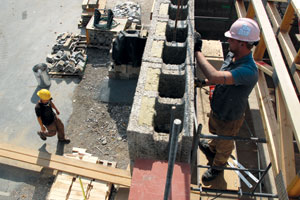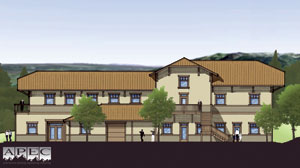COLUMBIA FALLS – Timber framers Jeremiah Anderson and Jebb Lackey got tired of the building culture created during the Flathead Valley’s recent construction boom, where the emphasis was on haste and profit over quality and slapdash jobs by a few hurt everyone’s reputation.
They wanted to take part in projects where they had ownership from start to finish and could take pride in the final results.
So the duo joined with about 10 other tradesmen, forming a growing guild of workers who emphasize “green” building. Each member brings expertise in their craft, but is committed to learning other trades, too, in order to help on all stages of a project.
“Before, a trade comes in, does their part of a job, leaves and isn’t so sure what happened before or after them,” Anderson, who runs the building company Balancing Axe, said. “The culture on this project is totally different. We’re invested from start to finish and we know we’re building something that could last 300 years – not need a total rebuild in two, because it was bad to start with.”
The building group’s first eco-friendly project, an office complex on Nucleus Avenue in Columbia Falls, is underway. When completed, the 9,000-plus-square-foot building will house Glacier DRS, Inc., a Columbia Falls contracting business, and up to five other businesses.
 |
|
Ryan Davis, right, measures a section of wall built with Durisol blocks during the construction of The Cosley Building in Columbia Falls. |
Glacier DRS owner Dave Renfrow began considering the project when his business was outgrowing its old location. Rather than just build a stand-alone office, Renfrow wanted something that would bring other businesses and new life to Columbia Falls’ uptown district.
Renfrow was familiar with some green-building practices: Glacier DRS contracts finishing work for public and private buildings mostly in the San Francisco Bay area where most buildings, he said, are LEED certified. But he wondered if the concept would catch on in Columbia Falls. Meeting Anderson, he said, brought him a whole new awareness of green building.
“To me, what’s exciting is that this is where sustainable meets the mainstream,” Renfrow said. “Whether you call it green or not, whether you’re Republican or Democrat, conservative or liberal, it doesn’t matter. This is just good, common sense building and we all need to adjust to having fewer resources.”
The walls of the Cosley Building, named after famous Glacier Park ranger and trapper Joe Cosley, are made out of stacked Durisol blocks, recycled lumber by products combined with cement. The blocks don’t harbor bugs and other pests, mold or rot like the walls of lumber frame houses. They have a four-hour fireproofing and stifle sound. And, because they fit together perfectly and can have the finishing layer applied directly to their side, they cut out unnecessary waste and extra building steps.
Most importantly, Anderson said, is the life expectancy of the building will be 300 years, whereas lumber frame buildings cap out at 80 years. The green building materials are still more expensive than lumber at about $13.65 per square foot compared to $12.75 per square foot. But considering how much longer they last, Anderson argues green makes more financial sense in the long run.
 |
|
A rendering of The Cosley Building that is currently under construction downtown Columbia Falls. |
Still, Anderson and Lackey say as timber framers they’re committed to using lumber. Sixty-five percent of the resources for the Cosley building are from the valley; 50 percent of them are from Columbia Falls, they said. All the building’s wood products are from the Western Building Center and F.H. Stoltze Land and Lumber Co.
“Our goal is to continue to use timber framing, and to support those resource-based businesses,” Anderson said. “But when you keep cutting down 200-year-old trees and turning them into studs with an 80-year lifespan, just do the math: You’re going to run out of trees. We need to pick and choose where they’re best used.”
The Columbia Falls building has drawn attention to the green building group – they’re scheduled for projects as far as two years out. To them, the fact that they’ve been well received in Columbia Falls, one of the most resource-based and conservative places in the valley, bodes well for the future of sustainable building.
“I think people are surprised when they drive by a green building and don’t see dreadlocks and tie-dye,” Lackey said.
“I think if we did something like this in Whitefish it’d be written off as high-end yuppie hoopla,” Anderson added. “Here, more than anywhere, it shows that it’s catching on because it just makes sense.”